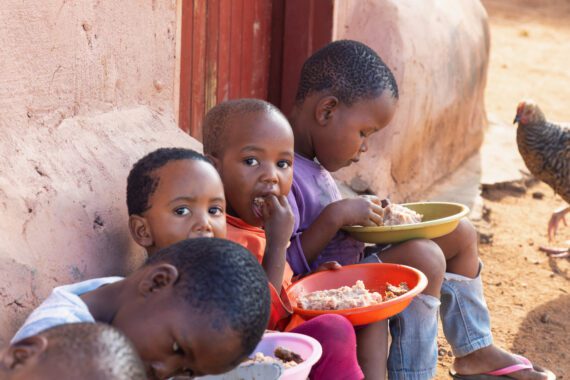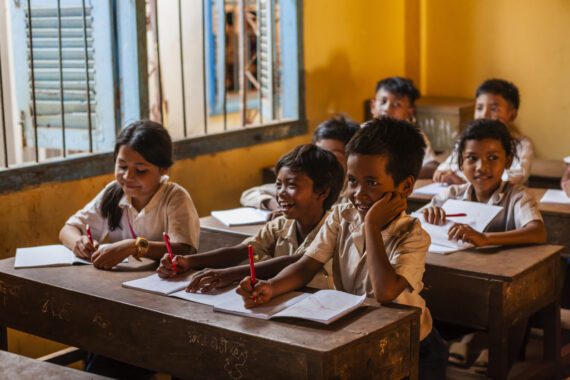Conflict is a main cause of hunger
- Conflict and climate change are the two main causes of global hunger emergencies.
- Of the countries or regional groupings on the most recent list of 20 “hunger hotspots,” food security specialists have identified conflict as a key driver of acute food insecurity in 10 countries and the Sahel region of Africa.
- Conflict can lead to hunger wherever it takes place. Conflict-affected hunger hotspots include Ethiopia; Somalia; South Sudan; Yemen; northern Nigeria; eastern Democratic Republic of the Congo (DRC); northern Mozambique; five countries in the central part of the Sahel region, just south of the Sahara Desert, particularly Burkina Faso; Syria; and Ukraine.
- Of the six countries identified this year as at immediate risk of famine or already facing famine conditions, five are currently engaged in armed conflict: Ethiopia, Somalia, South Sudan, Yemen, and northern Nigeria. The sixth, Afghanistan, experienced armed conflict for many years before the Taliban seized control of the government in 2022.
- People in these countries are already facing starvation or living with critical food insecurity in situations that are likely to worsen further.
Bread for the World’s work on hunger emergencies and conflict
- Bread has developed a set of guiding principles for hunger advocacy in conflict situations. The principles focus on preventing conflict, providing effective humanitarian responses during conflicts, and engaging in constructive ways to help post-conflict countries rebuild and recover.
- Bread’s ongoing advocacy for robust humanitarian food and nutrition assistance is essential to an effective response to hunger crises in countries where many people are hungry and malnourished because they are trapped in conflict zones. Bread members are longtime faithful advocates for people in hunger emergencies and helped to win additional humanitarian funding this year.
- In 2022, the monthly Institute Insights newsletter that Bread publishes includes Hunger Hotspots features on specific countries, such as Kenya and Mozambique, as well as issues such as the impact of the war in Ukraine and the unprecedented number of people confronting famine conditions.
Example: South Sudan
- South Sudan is one of the world’s newest countries, gaining independence from Sudan in 2011. Despite Sudan’s earlier civil war, which continued for decades, the transition to independence was peaceful.
- But by 2013, a dispute between political rivals within South Sudan’s ruling coalition ignited a new war. In a country roughly the size of Texas with a population of 11.5 million, one study found that nearly 400,000 people had been killed by 2018.
- At the end of 2021, 8.3 million people needed lifesaving humanitarian assistance. The country had 1.7 million internally displaced people as well as 2.3 million refugees in neighboring countries.
- A peace agreement was signed in 2018 between the government and the main rebel group, but four years later, little progress has been made toward implementing its provisions.
- Meanwhile, the violence has not stopped, fueled partly by factions that were not part of the agreement and people from local communities seeking revenge for earlier attacks.
- According to Human Rights Watch, by July 2021 the ongoing violence had “created the conditions for a devastating famine that now has millions in its grip.” About 8 million people in South Sudan are facing acute hunger.
- Conflict and hunger reinforce each other in a vicious cycle. Conflict destroys farms and forces farmers to flee, creating more hunger. In turn, as Concern USA explains, food shortages lead to intense competition for resources, cattle theft, and other actions that raise the potential for further violence.
- Members of the U.N. Commission on Human Rights in South Sudan met with stakeholders in October 2022 in neighboring Ethiopia. According to the commission, South Sudan’s conflict has become increasingly complex, but the level of suffering for millions of civilians remains intolerable. The experts said that the peace agreement must be fully implemented at once to stem the loss of life.
- Commissioner Barney Afako, a member of the U.N. Commission on human rights in South Sudan, described the situation in bleak terms: “Every month we see thousands of South Sudanese cross borders […] or move around the country trying to dodge an ever-shifting mosaic of violence that hardly registers regionally or internationally. Aid agencies struggle even to raise enough money to feed the victims because South Sudan has become invisible in the wake of other crises around the world.”



